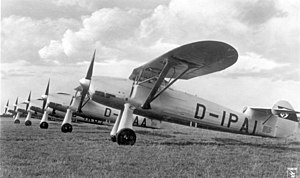| Focke-Wulf Fw 56 | |
|---|---|
| Focke-Wulf Fw 56 | |
| Role | Advanced Trainer |
| Manufacturer | Focke-Wulf |
| First flight | November 1933 |
| Primary user | III German Reich |
| Number built | ~1000 |
The Focke Wulf Fw 56 Stösser (German : Goshawk) was a single-engine, high-wing monoplane advanced trainer, built in the 1930s in Germany.
Design[]
It was developed, in accordance with a request by the Reich Air Ministry for an advanced fighter trainer, by Kurt Tank, chief engineer with Focke-Wulf. It was also considered for possible use as a home defence fighter. The first prototype flew for the first time in November 1933. A second prototype had some modifications made to the fuselage, and metal rather than wooden wings for flight testing. The third prototype, which flew in February 1934, reverted to the wooden wing and satisfied the technical designers.
After comparison flights in 1935 against its two competitors - the Arado Ar 76 and the Heinkel He 74 - the Air Ministry ordered production to begin. About 1,000 aircraft were built, mostly used by Germany, though numbers were used by Austria and Hungary. A few were sold for private use, for instance to Gerd Achgelis, who later founded the helicopter company Focke-Achgelis with Henrich Focke.
Ernst Udet, an advocate of the use of dive bombers, tested the second prototype - Fw 56 V2 - in this role, and on his recommendation the development of dive bombers was given greater attention.
The Fw 56 was a high-wing aircraft with a fuselage of steel tubes, clad in metal at the front, and canvas elsewhere. The wing was of wood, clad mostly in plywood, while the trailing edge was covered with material. The three-point undercarriage was fixed and possessed a tail skid.
Variants[]
- Fw 56a : First prototype.
- Fw 56 V2 : Second prototype.
- Fw 56 V3 : Third prototype.
- Fw 56A-0 : Three pre-production aircraft.
- Fw 56A-1 : Single-seat advanced trainer. Main production version.
Operators[]
Specifications (Fw 56A-1)[]
Data from Die Deutsche Luftrüstung 1933-1945[2]
General characteristics
- Crew: 1
- Length: 7.6 m (24 ft 11 in)
- Wingspan: 10.5 m (34 ft 5 in)
- Height: 2.6 m (8 ft 6 in)
- Wing area: 14 m2 (150 sq ft)
- Empty weight: 755 kg (1,664 lb)
- Gross weight: 985 kg (2,172 lb)
- Powerplant: 1 × Argus As 10C inverted V-8 air-cooled piston engine, 176.5 kW (236.7 hp) (converted from PS)
Performance
- Maximum speed: 278 km/h (173 mph; 150 kn) at sea level
- Cruising speed: 255 km/h (158 mph; 138 kn)
- Landing speed: 90 km/h (56 mph)
- Range: 385 km (239 mi; 208 nmi)
- Service ceiling: 6,200 m (20,341 ft)
- Rate of climb: 8.42 m/s (1,657 ft/min)
- Time to altitude: 1,000 m (3,281 ft) in 2.2 minutes
Armament
- Guns: 2 × 7.92 mm (.312 in) MG 17 machine guns
See also[]
References[]
- ↑ "Spanish Civil War Aircraft". http://www.zi.ku.dk/personal/drnash/model/spain/did.html. Retrieved 2011-06-14.
- ↑ Nowarra, Heinz J. (1993). Die Deutsche Luftrüstung 1933-1945 : Band 2 Flugzeugtypen Erla-Heinkel. 2 (1st ed.). Switzerland: Bernard & Graefe Verlag. pp. 57–59 & 264–265. ISBN 3 7637 5466 0.
External links[]
| Wikimedia Commons has media related to Focke-Wulf Fw 56. |
- http://aviationtrivia.info/Focke-Wulf-FW-56-Stosser.php
- http://www.warbirdsresourcegroup.org/LRG/fw56.html
- http://www.luftfahrtmuseum.com/htmi/itf/fw56.htm
The original article can be found at Focke-Wulf Fw 56 and the edit history here.
